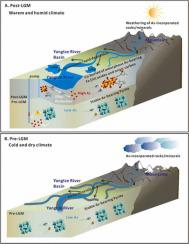Journal of Hazardous Materials ( IF 12.2 ) Pub Date : 2022-07-28 , DOI: 10.1016/j.jhazmat.2022.129684 Yuxiao Xu 1 , Yamin Deng 1 , Tianliang Zheng 2 , Yao Du 1 , Hongchen Jiang 3 , Kunfu Pi 1 , Xianjun Xie 1 , Yiqun Gan 1 , Teng Ma 1 , Yanxin Wang 1

|
The prevalence of arsenic (As)-affected groundwater in the Late Pleistocene and Holocene aquifers leads to serious arsenicosis worldwide. However, the geogenic foundational processes underlying the high As aquifers remain elusive. Here we present joint lines of evidences from chronological, sediment geochemical and geomicrobial analysis that climate change since the Last Glacial Maximum (LGM) initiates the genesis of high As aquifers in the central Yangtze River Basin, which represents Quaternary alluvial-lacustrine floodplains affected by arsenicosis occurrence. Optically stimulated luminescence-based sediments dating and grain size characterization indicate that the LGM depositional boundary also separates the Late-Pleistocene/Holocene high arsenic aquifers from the underlying arsenic-depleted aquifers. Further examination of solid-phase As/Fe/S speciation and associated microbial communities function suggests that the pre-LGM depositional environments characteristic of S metabolism engender the fixation of As in pyrite, whereas during the post-LGM period climate change to warm and humid leads to As repartitioning to Fe/Mn oxides in response to strong chemical weathering. This may have contributed to a dynamic fate of As in the post-LGM depositional environments and thus a highly variable aqueous As concentrations over depth. Our results highlight the important roles of climate change has played in the genesis of high As aquifers, with implications for other LGM-affected regions worldwide as well as for the evolution of high arsenic aquifers under future climate change.
中文翻译:

长江中部高砷含水层形成与末次盛冰期以来气候变化的新证据
晚更新世和全新世含水层中受砷 (As) 影响的地下水普遍存在,导致世界范围内严重的砷中毒。然而,高砷含水层背后的地质基础过程仍然难以捉摸。在这里,我们提出了来自年代学、沉积物地球化学和地球微生物分析的联合证据表明,自末次盛冰期 (LGM) 以来的气候变化引发了长江中部高 As 含水层的形成,该含水层代表了受砷中毒影响的第四纪冲积湖漫滩发生。基于光激发发光的沉积物测年和粒度表征表明,LGM 沉积边界还将晚更新世/全新世高砷含水层与下方的贫砷含水层分开。对固相 As/Fe/S 形态和相关微生物群落功能的进一步研究表明,S 代谢的前 LGM 沉积环境特征导致 As 固定在黄铁矿中,而在 LGM 后时期气候变化为温暖和潮湿导致 As 在强烈的化学风化作用下重新分配为 Fe/Mn 氧化物。这可能导致了 LGM 后沉积环境中 As 的动态命运,因此水性 As 浓度随深度变化很大。我们的研究结果强调了气候变化在高砷含水层的形成中发挥的重要作用,对全球其他受 LGM 影响的地区以及未来气候变化下高砷含水层的演变具有影响。











































 京公网安备 11010802027423号
京公网安备 11010802027423号